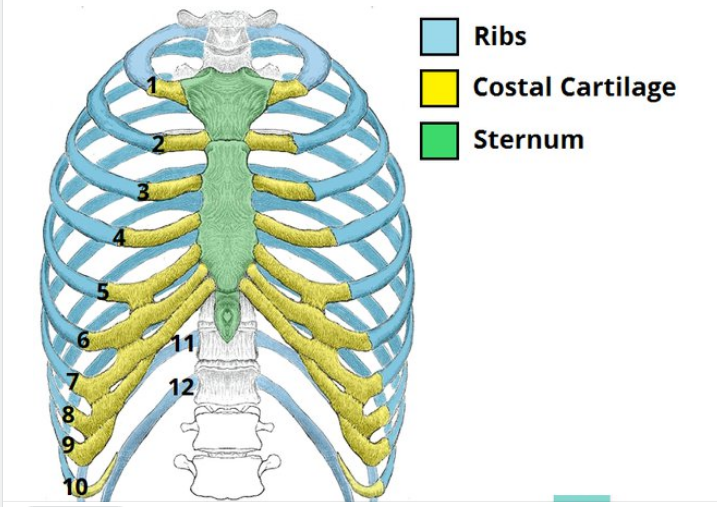Men and women have 12 pairs of ribs (a few individuals have 13 or 11 pairs). The idea that men have fewer ribs than women is widespread but wrong, perhaps deriving from the biblical story of Eve being made from one of Adam’s ribs.

The first category of ribs, known as true ribs, comprises the initial seven pairs. True ribs are aptly named because they have a direct attachment to the sternum or breastbone through a cartilaginous structure called the costal cartilage. This attachment provides stability to the ribcage and is important in the mechanics of respiration. The true ribs also work as a protective shield for the heart and lungs.
Following the true ribs, there are three pairs of false ribs. These ribs, numbered 8th to 10th, differ from true ribs in that they do not attach directly to the sternum. Instead, they connect indirectly to the sternum through the costal cartilage of the rib above them. This arrangement gives them the name “false ribs.” While they lack the direct connection of true ribs, they still contribute to the structural integrity of the ribcage and offer additional protection to the abdominal organs.
Lastly, the 11th and 12th pairs of ribs are referred to as floating ribs. Unlike true and false ribs, they do not attach to the sternum or its cartilage at all. These ribs have a free, unattached anterior end. Although they have a limited role in the mechanics of respiration, floating ribs protect the lower organs like the kidneys, from potential damage.
Collectively, these ribs form the ribcage which contribute to the process of breathing. As the ribcage expands during inhalation and contracts during exhalation, it aids in the expansion and contraction of the lungs, enabling the intake of oxygen and the removal of carbon dioxide.

Male vs female rib cage at a glance
Male vs Female Ribs: Key Differences
| Basis of Comparison | Male Ribs | Female Ribs |
| Size and Length | Generally larger and longer | Smaller and shorter |
| Angle of the Ribs | Often greater angle relative to the spine | Less angle, resulting in a narrower chest |
| Shape of the Sternum | Wider and more rounded | Narrower and may have a slight triangular shape |
| Costal Cartilage | Longer costal cartilage | Shorter costal cartilage |
| Rib 1 | Less mobile and often more firmly attached to the sternum | More mobile and less firmly attached |
| Floating Ribs (11 and 12) | May be slightly longer and less mobile | Slightly shorter and less mobile |
| Rib Angle and Flare | Greater angle and flare outward | Less pronounced angle and less flare |
| Ribcage Shape | More cylindrical | Slightly conical |
| Rib Alignment | May exhibit a more “V” shape | May appear more “U” shaped |